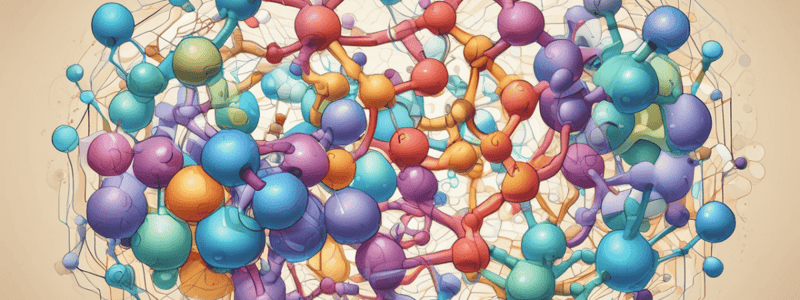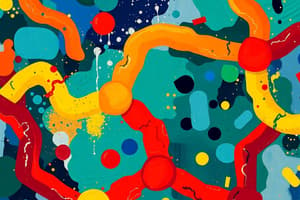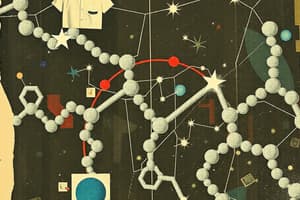Podcast
Questions and Answers
What type of glycosylation involves the -OH of Thr and Ser?
What type of glycosylation involves the -OH of Thr and Ser?
- Phosphorylation
- O-linked (correct)
- C-linked
- N-linked
What is the primary structure of a protein?
What is the primary structure of a protein?
- The sequence of amino acids in a peptide chain (correct)
- The folding of a peptide chain into a β-pleated sheet
- The quaternary structure of a protein
- The 3D structure of a protein
What is the function of hydrogen bonds in an α-helix?
What is the function of hydrogen bonds in an α-helix?
- To form disulphide bridges
- To stabilise the α-helix structure (correct)
- To hold the peptide chain in a β-pleated sheet
- To form an electrostatic interaction
What type of β-sheet structure is widespread in globular proteins?
What type of β-sheet structure is widespread in globular proteins?
What is the function of collagen triple helix?
What is the function of collagen triple helix?
What is the quaternary structure of haemoglobin?
What is the quaternary structure of haemoglobin?
What is the percentage of α-helix structure in haemoglobin?
What is the percentage of α-helix structure in haemoglobin?
What is the type of protein that has a high percentage of β-sheet structure?
What is the type of protein that has a high percentage of β-sheet structure?
What is the primary function of the peptide bond in proteins?
What is the primary function of the peptide bond in proteins?
What type of bond is involved in the interaction between the δ– and δ+ charges?
What type of bond is involved in the interaction between the δ– and δ+ charges?
What is the role of the nitrogen and oxygen atoms in the peptide bond?
What is the role of the nitrogen and oxygen atoms in the peptide bond?
What is the main structural feature of an α-helix?
What is the main structural feature of an α-helix?
Which of the following is an example of a hydrogen bond acceptor?
Which of the following is an example of a hydrogen bond acceptor?
What type of interactions are responsible for maintaining the tertiary structure of proteins?
What type of interactions are responsible for maintaining the tertiary structure of proteins?
What is the approximate energy of a hydrogen bond?
What is the approximate energy of a hydrogen bond?
Which of the following is an example of an electrostatic interaction?
Which of the following is an example of an electrostatic interaction?
What is the significance of conformation in determining the biological functions of proteins?
What is the significance of conformation in determining the biological functions of proteins?
What is the result of defects in amino acid metabolism and mis-folding?
What is the result of defects in amino acid metabolism and mis-folding?
What is the primary reason for hydrophobic regions of a protein folding in a particular way?
What is the primary reason for hydrophobic regions of a protein folding in a particular way?
What is the distance at which Van der Waals forces operate?
What is the distance at which Van der Waals forces operate?
What is the function of the NH3⁺ group in a polypeptide?
What is the function of the NH3⁺ group in a polypeptide?
Which of the following is NOT an example of a hydrogen bond donor?
Which of the following is NOT an example of a hydrogen bond donor?
What type of modification is involved in the formation of disulphide bridges?
What type of modification is involved in the formation of disulphide bridges?
What is the term for the unequal distribution of electrons in a covalent bond?
What is the term for the unequal distribution of electrons in a covalent bond?
What is the primary reason for the sensitivity of proteins to denaturation?
What is the primary reason for the sensitivity of proteins to denaturation?
What is the main factor that determines the final structure of a protein?
What is the main factor that determines the final structure of a protein?
Why is misfolding of proteins associated with disease?
Why is misfolding of proteins associated with disease?
What is the primary reason for the stability of proteins?
What is the primary reason for the stability of proteins?
What is the main consequence of denaturation of proteins?
What is the main consequence of denaturation of proteins?
What is the primary role of the amino acid sequence in protein folding?
What is the primary role of the amino acid sequence in protein folding?
Flashcards
Protein Function
Protein Function
Proteins perform various biological tasks, including structural support, movement, catalysis, transport, signalling, and more.
Collagen
Collagen
A structural protein, providing strength and support in tissues like skin and cartilage.
Actin/Myosin
Actin/Myosin
Proteins responsible for muscle contraction and movement.
Enzyme
Enzyme
Signup and view all the flashcards
Hemoglobin
Hemoglobin
Signup and view all the flashcards
Amino Acid Structure
Amino Acid Structure
Signup and view all the flashcards
Amino Acid Interactions
Amino Acid Interactions
Signup and view all the flashcards
Disulfide Bridge
Disulfide Bridge
Signup and view all the flashcards
Protein Primary Structure
Protein Primary Structure
Signup and view all the flashcards
Protein Secondary Structure
Protein Secondary Structure
Signup and view all the flashcards
Protein Tertiary Structure
Protein Tertiary Structure
Signup and view all the flashcards
Protein Quaternary Structure
Protein Quaternary Structure
Signup and view all the flashcards
Alpha-Helix
Alpha-Helix
Signup and view all the flashcards
Beta-Sheet
Beta-Sheet
Signup and view all the flashcards
Collagen Triple Helix
Collagen Triple Helix
Signup and view all the flashcards
Hydrogen Bond
Hydrogen Bond
Signup and view all the flashcards
Electrostatic Interactions
Electrostatic Interactions
Signup and view all the flashcards
Van der Waals Forces
Van der Waals Forces
Signup and view all the flashcards
Hydrophobic Effect
Hydrophobic Effect
Signup and view all the flashcards
Protein Denaturation
Protein Denaturation
Signup and view all the flashcards
Protein Folding
Protein Folding
Signup and view all the flashcards
Study Notes
Protein Structure and Function
- Proteins perform various biological functions, including structural, movement, enzymatic, transport, membrane transport, hormonal, receptor, defense, and gene regulation.
- Examples of proteins and their functions:
- Structural: collagen, keratin
- Movement: actin, myosin
- Enzymes: trypsin, DNA polymerase
- Transport: haemoglobin, transferrin
- Membrane transport: Na+/K+ pump
- Hormones: insulin
- Receptors: acetyl choline receptor
- Defence: antibodies, clotting factors
- Gene regulation: histones
- Chromosome separation: tubulin
Amino Acids and Polypeptides
- Amino acids have a specific structure, with a NH3+ group at the N-terminal end and a COO- group at the C-terminal end.
- Amino acid side chains can form various interactions, including hydrogen bonds, ionic, van der Waals, and hydrophobic interactions.
- Disulphide (S-S) bridges can form between two cysteine residues, joining subunits together (e.g., insulin).
- Glycosylation can occur, with O-linked and N-linked modifications.
Protein Structure
- 3D structure has four levels: primary, secondary, tertiary, and quaternary.
- Primary structure: sequence of amino acids in the peptide chain.
- Secondary structure: folding/coiling of the peptide chain, often into α-helix or β-pleated sheet.
- Tertiary structure: peptide chain folds upon itself, forming a 3D structure.
- Quaternary structure: folded peptide chains join together to form a functional protein.
α-Helix
- Formed by hydrogen bonds between peptide bonds in the same polypeptide chain.
- Hydrogen bonds formed between peptide bond carbonyl-O and H of N-H every 4th peptide.
- Regular right-handed helix, with 3.6 residues per turn, stabilized by hydrogen bonds.
- R groups on the outside, forming a rigid cylinder shape that provides architectural support for the protein.
β-Pleated Sheets
- Linear peptide chains held together by hydrogen bonds between peptide chains.
- Side chains in each strand alternate above and below the plane of the sheet.
- Antiparallel and parallel β sheet structures exist.
Collagen Triple Helix
- Three chains held together by hydrogen bonds between chains.
- Found in collagen, with a left-handed helix and 3 residues per turn.
- Gly-X-Y-Gly-X-Y-Gly sequence, with X mainly proline and Y mainly hydroxy-proline.
Tertiary and Quaternary Structure
- Tertiary structure: how the whole polypeptide (subunit) is folded in 3D, consisting of different supersecondary structures (domains).
- Quaternary structure: how the whole functional protein is formed in 3D, possibly consisting of multiple subunits (e.g., haemoglobin α2β2).
Forces that Stabilize Protein Structure
- Covalent: disulphide bridges.
- Non-covalent: hydrogen bonds, electrostatic interactions, van der Waals forces, and the hydrophobic effect.
Hydrogen Bonds
- Formed between two electronegative atoms competing for the same H atom.
- Hydrogen bond donors (D): O, N, and NH3+.
- Hydrogen bond acceptors (A): O, N, and =N-.
Electrostatic Interactions
- Between charged side chains: Asp/Glu carboxyl groups (COO-) and Lys/Arg amino groups (NH3+).
Van der Waals Forces
- The sum of attractive or repulsive forces between molecules, excluding covalent bonds, hydrogen bonds, and electrostatic interactions.
- Dependent on dipole effects caused by the unequal distribution of electrons.
Hydrophobic Effects
- Hydrophobic regions of a protein fold to minimize contact with the aqueous environment, unable to form hydrogen bonds.
Protein Structure and Folding
- The amount of stabilization energy in a protein is quite small, making them sensitive to denaturation by pH, temperature, and ionic strength.
- Amino acid sequence encodes the final structure and the pathway that leads to that structure.
- Misfolding can cause disease.
Studying That Suits You
Use AI to generate personalized quizzes and flashcards to suit your learning preferences.




